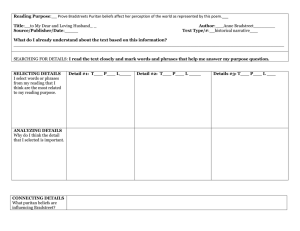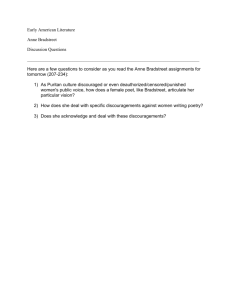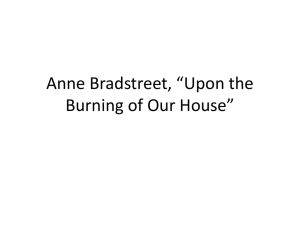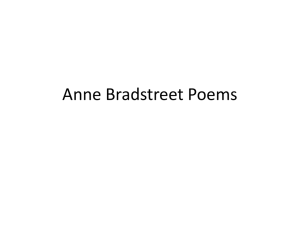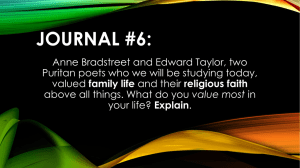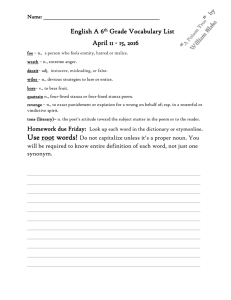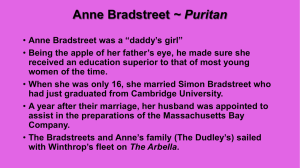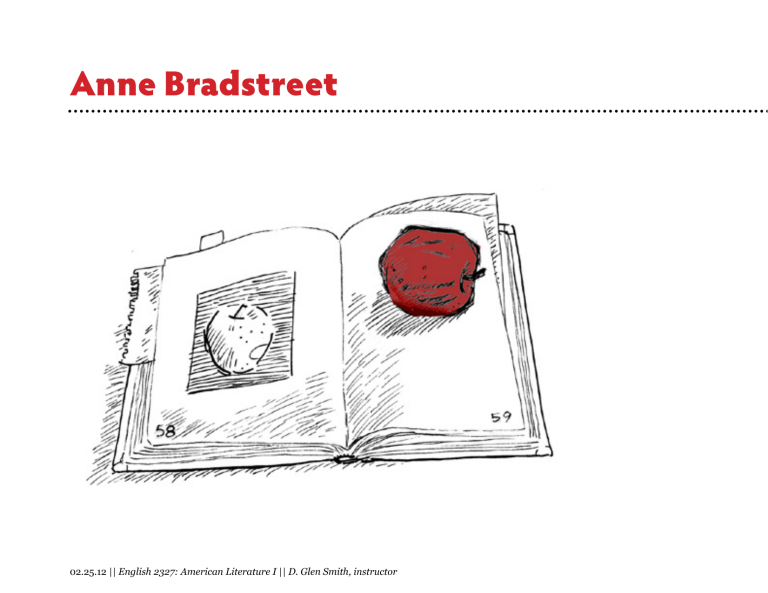
Anne Bradstreet 02.25.12 || English 2327: American Literature I || D. Glen Smith, instructor Early Colonial Literature With the establishment of the colonies, the settlers did not concentrate their agendas towards producing what today is considered typical creative expressions. Writers of the time in the Early Colonial period did produce interesting and unique products however. • their goals were idealistic and restrictive; little room for individuality • the main forms of creative expression were reserved for such genres as: > sermons > religious meditations > political discourse / pamphlet debates • theatre was outlawed: as a result no dramas • fiction and poetry were generally avoided in a public atmosphere; handfuls of personal journals do exist showing in private, poetry was created 02.25.12 || English 2327: American Literature I || D. Glen Smith, instructor 2 Early Colonial Literature Two authors who are typically anthologized: Anne Bradstreet, The Tenth Muse Lately Sprung Up in America (1650) Michael Wigglesworth, Days of Doom (1662) • both texts deal with the expectations of their time and location > display often specific, didactic tones > carry heavy themes of religion • both publications were used as a promotion of the success of New England • Bradstreet’s work was not created for publication; these poems show a private voice discussing personalized accounts of Puritan life • Wigglesworth’s work on the other hand is a strong example of the public voice; these poems offer a grim look at the consequences of sin during the apocalypse, during the Day of Judgment 02.25.12 || English 2327: American Literature I || D. Glen Smith, instructor 3 Early Colonial Literature Common Cultural Beliefs: • All of the books of the Bible were historical accounts. • The eventual Puritan migration to the New World was sanctioned by their church and God. • Oftentimes they would interpret the Bible in order to sanctify their actions. They would look for symbols in the text to justify their actions. This is similar to the religious doctrine of typology — reading an Old Testament story and show how it foreshadows or predicts an event in the New Testament. The story of Jonah was a prophecy of Christ (3 days in whale=3 days in tomb); in the Puritans case, they would use the Bible as a means of foreshadowing their own experiences in the New World. 02.25.12 || English 2327: American Literature I || D. Glen Smith, instructor 4 Early Colonial Literature • They considered New England as the New Jerusalem, the Promised Land. By reading and re-reading the Bible, they sought symbols and analogies of the presence of God, and tried to apply these to the existing world around them. • With the Bible as a model, the Puritans wanted to create a perfect society and stainless church—on their terms. 02.25.12 || English 2327: American Literature I || D. Glen Smith, instructor 5 Anne Bradstreet According to tradition, it has been said that Anne Bradstreet’s full book, The Tenth Muse Lately Sprung Up in America, was published against her will. In 1647 Bradstreet’s brother-in-law, John Woodbridge, left the colonies to return to England. • He had it published in London as: The Tenth Muse, lately Sprung up in America, or Several Poems Compiled with Great Variety of Wit and Learning, Full of Delight, Wherein especially is Contained a Complete Discourse and Description of the Four Elements, Constitutions, Ages of Man, Seasons of the Year, together with an exact Epitome of the Four Monarchies, viz., The Assyrian, Persian, Grecian, Roman, Also a Dialogue between Old England and New, concerning the late troubles. With divers other pleas and serious Poems, By a Gentlewoman in those parts 02.25.12 || English 2327: American Literature I || D. Glen Smith, instructor 6 Anne Bradstreet The publication was an attempt by a group of Puritan men: her father Thomas Dudley; her husband, Simon Bradstreet; and Woodbridge, to show that a godly and educated woman could elevate the position held by a wife and mother, without necessarily placing her in competition with men. • educated herself with the means of her family’s extensive library • developed a strong sense of independence and self-worth for the time period • gained reputation for her literary skills, earning the title of Tenth Muse. • her extensive writings and strong self-value defends women’s causes, challenging the patriarchal society with ideas supporting the woman’s right to study, produce creative works, and read • was one of the 400 passengers aboard the Arbella which left England in 1630 with her father and husband under the leadership of John Winthrop 02.25.12 || English 2327: American Literature I || D. Glen Smith, instructor 7 Anne Bradstreet Critical Approaches for reading Bradstreet’s poems: • notice her persistent use of iambic pentameter— • then look for variations in rhythm; often a change in meter indicates an emphasis, retraction, or resolution to be stressed • double check denotations of her words; alternative and connotative understanding of a word or phrase may clarify or deepen meaning of her a feelings and ideas • examine the imagery shown; she often utilizes what are called metaphysical conceits or extended metaphors • examine her use of irony and subtle sarcasm • her use and alteration of the male Puritan cultural discourse • she will seem to question religious notions, then retract previous comments as a means of confirming established cultural concepts 02.25.12 || English 2327: American Literature I || D. Glen Smith, instructor 8 Anne Bradstreet “Prologue” as the opening poem to the book takes on a very public voice and establishes common techniques for Bradstreet’s poetry. • The poet-self is introduced and shown with strong presence in the work. • The poet-speaker has a strong sense of individuality. • Its construction follows a pattern of: > a formulaic rhyme scheme of ABABCC > iambic pentameter > sestet stanzas • The work also uses a running motif of an artist seemingly apologizing for the quality of his/her work: self-effacing statements slowly becoming an authority. This is a common technique for the time period. In Bradstreet’s case, her work as presented by a female author had a strong chance of not being well received. 02.25.12 || English 2327: American Literature I || D. Glen Smith, instructor 9 Anne Bradstreet • However, part of the material used here has a secondary message which is not as obviously apologetic as it appears at first glance. stanza 1: • Bradstreet establishes that she will not write of historical matters such as kings, wars, nor heros. Her work is not worthy for such masculine matters. stanza 2: • She states she is not as good as the French devotional poet Bartas. However, she expresses she does have a skill of her own merit. This is not mere vanity. This is a statement of fact, of a want to write casual creative work. For the Puritans, as said before, poetry helped bridge a meditative state into a communication with the divine— just like prayer, the poet can move beyond the ordinary materialism of the world to express a hymn or chant of relevance. 02.25.12 || English 2327: American Literature I || D. Glen Smith, instructor 10 Anne Bradstreet stanza 3: • She states her muse is foolish, broken and blemished. The Greek Muse of lyric poetry (love and erotic) was named Erato, the Muse for epic poetry was named Calliope. The Greeks divided the works of poetry into these two groupings. • Through Bradstreet’s verse, you can perhaps take the analogy a step further: Erato was more musical in origins, whereas Calliope was meant for drama. With this in mind, Bradstreet’s mentioning her in stanza 6 is appropriate. • Traditionally the Muses are invoked at or near the beginning of an ancient epic poem or classical Greek hymn. • Sometimes they are represented as a living influence, an embodiment for whom an author is merely a mouthpiece. Muses in a sense possess the poet. • Bradstreet takes the concept to a different level, referring to the muse as a neuter “it” as a state of being, or as a psychological state of personality. 02.25.12 || English 2327: American Literature I || D. Glen Smith, instructor 11 Anne Bradstreet stanza 4: • She continues her self-depreciation tone in this section, strategically overstating the theme. This is a loud hint towards sarcasm. • She alludes to Ancient Greek philosopher, Demosthenes, who traditionally is depicted as having a major speech defect, but conquered it to become a famed speaker of renown rhetoric. Important items to consider: • In her case what is the source of her brain’s “weakness” or “wound”? • If she is so wounded, then why is she writing so well here? • Is she suggesting that women may have their own special poetic gifts? • If so, what might those gifts be, according to this poem? 02.25.12 || English 2327: American Literature I || D. Glen Smith, instructor 12 Anne Bradstreet stanza 5: • At this stage, her tone changes. This stanza acts as a defense for her writing: she stresses it is okay for a woman to want to write; in other words women have other talents beyond needlework— an craft which serves a function and as a decoration. stanza 6: • Stanza six falls into some difficult syntax; however, here Bradstreet does make her most pronounced argument for the value of women in the arts. She does this by appealing to the respect which the male writers of the time held for the Ancient Greeks. The Renaissance and Jacobian eras valued the Greek/Roman texts as highest art possible. These same men placed little value in the contributions of women’s roles in society. 02.25.12 || English 2327: American Literature I || D. Glen Smith, instructor 13 Anne Bradstreet Bradstreet recognizes the fallacy and uses it as a logical paradoxal statment: 1. The Greeks readily accepted the woman’s role in the arts, valued women in the arts, even personified the arts themselves as women. 2. her male readers will have to accept the Greek position as well, or 3. they will have to accept that “The Greeks did nought but play the fools and lie,” which would also subtly deride the reader who has chosen to exalt the Greeks. 4. This debate undermines all the apologies she makes elsewhere in the “Prologue.” All the preceding stanzas seem merely to soften her audience for this one allowance of unmistakable support for women in the arts. • Line 5 mentions a “knot”— which refers the argument expressed in the poem itself. 02.25.12 || English 2327: American Literature I || D. Glen Smith, instructor 14 Anne Bradstreet • Overall, in this section she takes the standard technique of opening a book with apparent humilty and twists it into a political-social commentary. stanza 7: • Line 38 uses the word “precedency”: meaning “first place in society”— Certainly in her time and place, the hierarchy was strongly set in place by the men themselves. Note that she says they have precedency, not that they necessarily deserve it. This subtlety reenforces her sarcastic wit. • In Line 40 she speaks with half sarcastic tone acknowledging the situation of the patriarchy’s control. • In line 41 of she addresses specifically to men who are critical of women’s work. Using the analogy of the Ancient Greeks to show how women could be endowed, she steps back slightly and acquiesces making a simpler request: Grant women some acknowledgment of their worth. 02.25.12 || English 2327: American Literature I || D. Glen Smith, instructor 15 Anne Bradstreet • This action in itself is a Renaissance rhetorical stratagem which allows her requests to appear delivered with a sense of humility. At the same time, her message is delivered as a fact of the times. • Some critics have gone so far as to give her the title of America’s first feminist voice. stanza 8: • Again, subtle humor exists in line 46 where she utilizes the phrase “thyme or parsley wreath”— these were common household items of the time for spices, but a “bay” is a laurel wreath (as the book states). These are poisonous, not meant for cooking. • The last stanza wraps up the full poem’s theme of self-depreciation by stating that although her work is “unrefined,” it will make others’ poetry seem shining gold. 02.25.12 || English 2327: American Literature I || D. Glen Smith, instructor 16 Cultural Views of the Dwelling Three items to keep in mind: • the physical house symbolizes the feminine principle • maintaining a house is the stereotypical role of female control • a well-kept house culturally is shown as a symbol of the successful woman; likewise, this image signifies one’s status, or position in society; it is after all a dwelling which houses one’s possessions • in the Christian tradition a church, the House of God, is often personified in the female gender: Christ is seen as the male counterpart who is married to the church 02.25.12 || English 2327: American Literature I || D. Glen Smith, instructor 17 from the Geneva Bible, 1599 Ephesians 5:22-33 22 Wives, submit yourselves unto your husbands, as unto the Lord. 23 For the husband is the wife’s head, even as Christ is the head of the Church, and the same is the Saviour of his body. 24 Therefore as the Church is in subjection to Christ, even so let the wives be to their husbands in everything. 25 Husbands, love your wives, even as Christ loved the Church, and gave himself for it, 26 That he might sanctify it, and cleanse it by the washing of water through the word, 27 That he might make it unto himself a glorious Church, not having spot or wrinkle, or any such thing; but that it should be holy and without blame. 28 So ought men to love their wives, as their own bodies. He that loveth his wife, loveth himself. 02.25.12 || English 2327: American Literature I || D. Glen Smith, instructor 18 from the Geneva Bible, 1599 Ephesians 5:22-33 29 For no man ever yet hated his own flesh, but nourisheth and cherisheth it, even as the Lord doeth the Church. 30 For we are members of his body, of his flesh, and of his bones. 31 For this cause shall a man leave father and mother, and shall cleave to his wife, and they twain shall be one flesh. 32 This is a great secret, but I speak concerning Christ, and concerning the Church. 33 Therefore every one of you, do ye so, let every one love his wife, even as himself, and let the wife see that she fear her husband. 02.25.12 || English 2327: American Literature I || D. Glen Smith, instructor 19 Upon the Burning of Our House This poem mirrors the Puritan model for meditation. Three distinct movements exist within the structure: 1. the object or situation is experienced (house burns) 2. the author relates to the object or event (she searches for meaning) on personal levels 3. the author channels the full experience (consoles herself) to the Divine By acknowledging God establishes an ultimate path for everyone, and by consenting to the fact that her own fate is outside of her own control, Bradstreet gains an acceptance of her loss. 02.25.12 || English 2327: American Literature I || D. Glen Smith, instructor 20 Upon the Burning of Our House Seven Stages of Grief Expressed through the Nine Stanzas Seven Stages of Grief Nine Stanzas 1. Shock and denial stanza 1 2. Pain and guilt stanza 2 3. Anger and/or bargaining stanza 3 short burst of acceptance opening couplet of stanza 4 4. Depression, reflection, loneliness stanza 4 - 6 5. Upward turn stanza 7 6. Reconstruction stanza 7 7. Acceptance and hope stanza 8 - 9 02.25.12 || English 2327: American Literature I || D. Glen Smith, instructor 21 Upon the Burning of Our House Stanza One • Opens with the scene almost immediately, interrupting her from sleep. • Notice lines 5-6 specifically which relate how she hopes no one experiences the same trauma. Stanza Two • Calls out to God not to leave her without support Stanza Three • Bradstreet seems to praise and defend God’s actions. • Critics note she allows herself to question His judgement as a means to reconcile herself that the fire is the will of God. A common psychological reaction to trauma even today. 02.25.12 || English 2327: American Literature I || D. Glen Smith, instructor 22 Upon the Burning of Our House Stanza Three • At this stage of the poem, the tone expresses a more ambiguous feeling, rather than religious certainty— the words echo more as a psychological reaction to bad news, a habitual expectation from a Puritanical society, rather than as an expression of resignation to God’s will. • Line 15 seems to favor more regret than surrender to the Divine Stanza Four – Six • She soon falls into discussing her misfortunes and loss of material goods. • This results in the psychological reaction to absence and lack of property. 02.25.12 || English 2327: American Literature I || D. Glen Smith, instructor 23 Upon the Burning of Our House Closing Stanzas • Critics have commented the remainder of the poem relies heavy on a religious convention that all in life is vanity, everything is temporal. • Likewise some have said this allows an easy answer to a difficult situation— the use of an expected analogy, however, it seems more to exist as a means of relying on her own Puritan values, to show how her faith can restore peace. • The poem in full acts as a confirmation, rather than a questioning of God’s Laws. • William Scheick suggests that the use of allusions to scripture likewise opposes heretical feelings of protest. Scheick, William. Authority and Female Authorship in Colonial America. Lexington: UP Kentucky, 1998. 02.25.12 || English 2327: American Literature I || D. Glen Smith, instructor 24 Upon the Burning of Our House Vocabulary Choice • Notice in stanza two she calls her residence “my dwelling place” (l 12) and in stanza three says that it was “yet sufficient for us” (l 20). • However in stanza eight she acknowledges that through God she has “an house on high erect, / framed by that mighty Architect” (ll 43-44). • This manages to show the dualism existing between the Mortal World and the Divine Realm. Only in heaven does she have a house, a true home “purchased and paid for too” (l 47). Following her Puritan teachings, her grief turns into production. 02.25.12 || English 2327: American Literature I || D. Glen Smith, instructor 25
